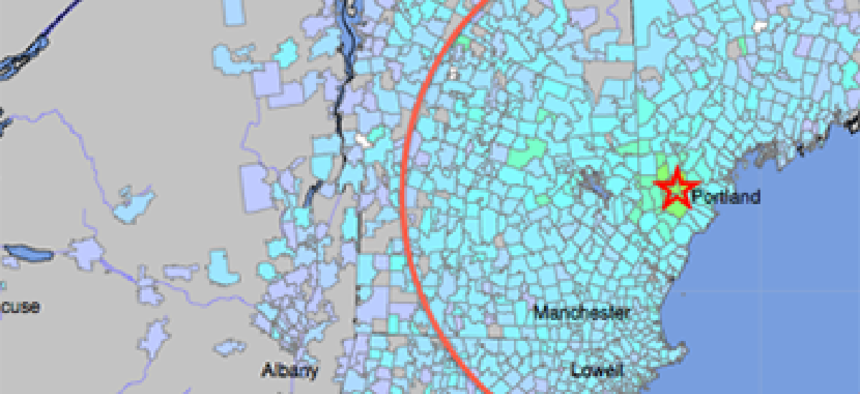Tweets give USGS early warning on earthquakes

The U.S. Geological Survey is finding an unexpected value in Twitter's brief, rapid widespread message capability.

USGS can often learn of earthquakes via Twitter before seismograph data can be transmitted – and even before some affected individuals begin to feel tremors. On this map of an Oct. 16, 2012, earthquake near Portland, Maine, the red circle shows how far from the epicenter tremors had travelled by the time tweets about it had been spotted by the agency’s Twitter Earthquake Dispatch system. (USGS image)
The word "earthquake" can conjure images of an old seismograph needle, scribbling jagged lines across a slowly scrolling page. These days, however, the United States Geological Survey's Twitter Earthquake Dispatch (TED) usually detects sizeable earthquakes before its sophisticated scientific instruments can convey the data.
On Aug. 31, 2012, TED sorted through thousands of real-time earthquake-related tweets in multiple languages and used time, geo-tagging and location data contained within the tweets to pinpoint a large earthquake in the Philippines and notified scientists before seismometers even picked it up.
In fact, "about half of the TED earthquake alerts arrive before instrumentally detected earthquakes," said USGS seismologist Paul Earle. The TED system, using public Twitter data, can detect earthquakes in anywhere from 30 seconds to two minutes. In remote areas, seismometers can take 20 minutes to confirm earthquakes.
While instrumentation picks up tens to hundreds of daily tremors that are not felt by population centers -- and therefore wouldn't register with TED because nobody is around to tweet them -- TED's use of social analytics provides USGS an early warning of widely-felt earthquakes.
"It gives us an initial heads-up that something is going on, kind of like saying, 'Hey, pay attention,'" said Earle, who runs the agency’s round-the-clock earthquake monitoring system at the USGS National Earthquake Information Center in Golden, Colo.
When TED registers a spike in earthquake-related tweets, it sends Earle a page to his phone, and he can use data from TED -- frequency of tweets, firsthand accounts of what people are saying (though Twitter users are not identified) and location data -- to make inferences about how powerful or widely felt the earthquake might be. The earthquake that struck the Washington, D.C., area in 2011, for example, reached 4,000 tweets per minute, Earle said -- a sure sign that people felt it was a big deal.
The early notice also allows seismologists to go and manually look at what the instruments are saying if they haven't registered an earthquake that TED has, and -- once seismically verified -- send out a tweet via the @USGSted Twitter account with an earthquake warning for a specified region.
"It gives me a chance to get on the computer and get things going and start to be engaged in the response process quicker," Earle said.
A cost-effective investment
While TED will not replace scientific instruments anytime soon in earthquake detection at USGS, it has improved what the agency does, Earle said. The USGS is the only federally mandated seismic network in the United States, and it is charged with notifying the White House, State Department, FEMA and other agencies in the event of a sizeable earthquake, and providing information with how to respond appropriately, so every minute counts.
"It's not changing the way we do seismic monitoring, but it is augmenting what we're doing, and it's relatively inexpensive," Earle said. "All this is really showing cost benefits."
TED was not an expensive agency foray into social media analytics. A graduate student created the tool three years ago with modest funding from the American Recovery and Investment Act, creating a way for USGS to cheaply monitor data that was already available publicly.
Justin Herman, new media manager at General Services Administration's Center for Excellence in Digital Government, said TED is a great example of how federal agencies can affordably "unlock the data they already have" to cut costs and improve services.
"Right now, we have agencies putting their feet in the water with things like predictive analytics and sentiment analysis, but the larger issue is how agencies are unlocking and using social data in order to improve services and cut costs," Herman said. "USGS is able to do it for earthquakes, the CDC for the flu -- it takes no stretch of the imagination to see how any mission in government could benefit from getting this data, analyzing it, making sense of it, and building strategies and tactics based on it."
The GSA-led Social Performance Metrics Working Group provides guidance to agencies in analyzing social data for sentiment analysis, performance metrics, disaster response and relief and other purposes. Herman said most of the tools the working group recommends to agencies looking to make use of social media data are either very cheap or free. He said the availability of those tools -- and the government's use of them -- is a "game-changer."
"Most of the things we're recommending to collect and look at to tap in and unlock this data is from freely available tools," Herman said. "When we talk about improving services and cutting costs with innovative technologies, (TED) is a great example of a mission being realized."






